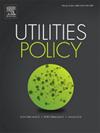Water for daily life: Estimating basic household water needs in Lima and Quito
IF 4.4
3区 经济学
Q3 ENERGY & FUELS
引用次数: 0
Abstract
This paper estimates the basic water needs, understood as the volume of water necessary to fulfill a household's core domestic activities, among low-income households in Lima (Peru) and Quito (Ecuador). It utilizes water utility records, detailed socioeconomic characteristics from a novel survey, and climate variables. In Lima, basic water needs are estimated at 15.9 m3 per household in July (winter) and 17.8 m3 in January (summer). With fewer seasonal variations in Quito, basic water needs are 20.2 m3 per household in both months. These results provide important insights for the design of water policies and tariff structures.
日常生活用水:估计利马和基多的基本家庭用水需求
本文估计了利马(秘鲁)和基多(厄瓜多尔)低收入家庭的基本水需求,即满足家庭核心家庭活动所需的水量。它利用了水公用事业记录、一项新调查的详细社会经济特征和气候变量。在利马,7月(冬季)每户的基本用水需求估计为15.9立方米,1月(夏季)为17.8立方米。基多的季节变化较小,两个月每户的基本用水需求为20.2立方米。这些结果为水政策和关税结构的设计提供了重要的见解。
本文章由计算机程序翻译,如有差异,请以英文原文为准。
求助全文
约1分钟内获得全文
求助全文
来源期刊

Utilities Policy
ENERGY & FUELS-ENVIRONMENTAL SCIENCES
CiteScore
6.80
自引率
10.00%
发文量
94
审稿时长
66 days
期刊介绍:
Utilities Policy is deliberately international, interdisciplinary, and intersectoral. Articles address utility trends and issues in both developed and developing economies. Authors and reviewers come from various disciplines, including economics, political science, sociology, law, finance, accounting, management, and engineering. Areas of focus include the utility and network industries providing essential electricity, natural gas, water and wastewater, solid waste, communications, broadband, postal, and public transportation services.
Utilities Policy invites submissions that apply various quantitative and qualitative methods. Contributions are welcome from both established and emerging scholars as well as accomplished practitioners. Interdisciplinary, comparative, and applied works are encouraged. Submissions to the journal should have a clear focus on governance, performance, and/or analysis of public utilities with an aim toward informing the policymaking process and providing recommendations as appropriate. Relevant topics and issues include but are not limited to industry structures and ownership, market design and dynamics, economic development, resource planning, system modeling, accounting and finance, infrastructure investment, supply and demand efficiency, strategic management and productivity, network operations and integration, supply chains, adaptation and flexibility, service-quality standards, benchmarking and metrics, benefit-cost analysis, behavior and incentives, pricing and demand response, economic and environmental regulation, regulatory performance and impact, restructuring and deregulation, and policy institutions.
 求助内容:
求助内容: 应助结果提醒方式:
应助结果提醒方式:


